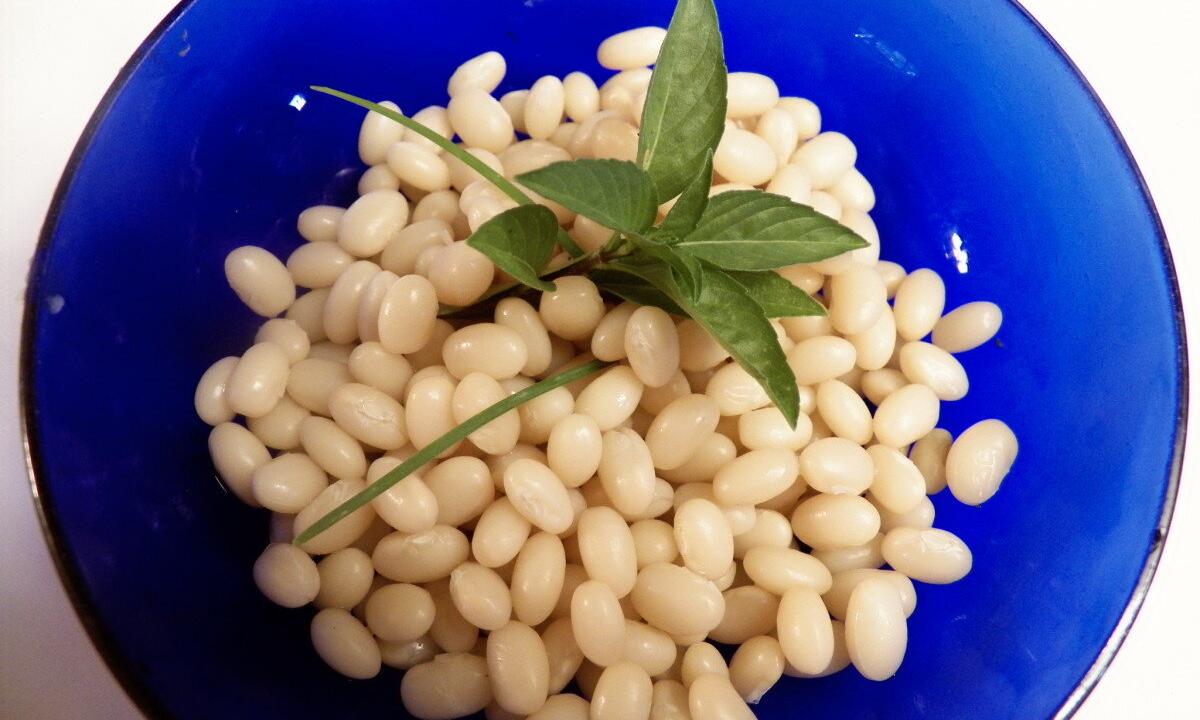Tinned haricot is demanded food product today. She is rich with useful elements, but also, in such look is convenient for the consumer as she does not demand a lot of time for preparation. We will talk about its useful properties and possible harm in this article.
Caloric content and structure
Caloric content tinned bean small — 114 kcal, in 100 g contain:
- proteins — 7.3 g;
- fats — 0.3 g;
- carbohydrates — 21.2 g;
- cellulose — 4.8 g.
Whether you know? Napoleon Bonaparte was a big fan of haricot, he called it feed for a brain and construction material for muscles.
Are present at structure:
- vitamins — B1, B2, B5, B6, B9, E, K, PP;
- macrocells — potassium, calcium, magnesium, sodium, phosphorus;
- minerals — iron, manganese, copper, selenium, zinc;
- amino acids — arginine, alanine, glycine, valine, methionine, an isoleucine, tryptophane, a lysine;
- fatty acids — an omega-3, an omega-6, palmitic, olein, linoleic.
Advantage and harm
Except that tinned haricot is already ready to the use, it has some more useful properties:
- not allergenic product;
- preservation keeps useful substances almost in full;
- the group of vitamins is health of nervous, endocrine, blood system, beauty and youth;
- cellulose facilitates digestion processes;
- minerals are responsible for health of heart, bodies of a GIT, blood formation, growth and formation of cages of an organism, work of a brain and other functions;
- the dish is recommended in many medical diets;
- low caloric content.
Important! At gastritis and an ulcer, pancreatitis preserved food can be used, but in limited quantities and not during exacerbation of a disease.
The product can do harm at abuse (meteorizm), at GIT diseases as haricot strengthens secretion of gastric juice.
Whether it is possible to eat
Whether tinned haricot at diabetes is safe whether it is admissible during pregnancy and in the period of a lactation and also if desired to lose weight, let's understand.
At pregnancy and GV
There are no contraindications to consumption of tinned vegetables during pregnancy, and haricot and at all is useful. The fact is that the product contains magnesium, calcium and potassium and also the majority of vitamins of group B which are necessary for normal incubation and health of a fruit and future mother.
Learn more about useful and harmful properties of white, red and siliculose beans.
Cellulose as a part of haricot will facilitate to the woman digestion processes, and during pregnancy to it often there are problems. Only caution: try to choose a product with the smallest amount of preservatives — vinegar, salt, foreign excipients.
The same concerns the lactation period. During breastfeeding haricot, especially if it was used during incubation, does not damage health of the kid. But it is necessary to eat it moderately, to watch constantly quality of a chair at the kid.
At weight loss
Haricot, including tinned, at a diet — very useful and recommended by nutritionists product. It is rich with protein, is quite capable to replace a meat dish, is successfully combined with vegetables, has low caloric content. Thanks to cellulose, exchange processes accelerate, hazardous substances are removed and fats are split.
Important! The growing thin people need to consider that haricot without tomato, in own juice will be more useful.
At type 2 diabetes
At diabetes of both the first, and second type haricot in a tinned look is not contraindicated.
On the contrary, it has many useful properties:
- improves a metabolism;
- strengthens bone and muscle tissue, a cardiac muscle;
- it has a low glycemic index;
- it is rich with the amino acids having the effect similar to insulin;
- the product is rich with minerals and vitamins which help to maintain the sight falling at a disease.
What can be prepared and what it is combined with
From tinned bean it is possible to prepare the mass of dishes:
- soup;
- ragout;
- to extinguish with tomato paste;
- to add to stewed vegetables, mushrooms, meat.
Study useful and harmful properties such bean as peas, lentil, mash, soy, chick-pea, a tamarind and a clover.
Preserved food can be added to baked pudding or to use as a stuffing for pies or pies, previously having merged liquid and having kneaded in puree.
How to choose upon purchase
Criteria for selection of a good product:
- suitable expiration date;
- lack of a muddy deposit (in a glass container);
- in accordance with GOST beans have to be the identical size;
- fasolina should not be rumpled;
- absence of inflation of a cover (in a tin container);
- from all auxiliary ingredients there have to be only a salt, sugar and drinking water.
Conservation with tomato paste considerably reduces a product period of storage.
How to store
Unambiguously opened jar needs to be stored in the fridge, from a tin container it is better to shift in a glass jar with a cover. To store no more day.
The closed capacity needs to be held at a temperature from 0 °C to +20 °C, it is not higher than 75% of humidity, in the dark room (cellar, the storeroom). Haricot is known in our diet long ago, it is nutritious and useful.
Whether you know? The dry white beans crushed in powder were used by Cleopatra as the bleaching means for face skin.
Preserved food is convenient in preparation, does not demand preliminary soaking as crude beans. Besides, from haricot it is possible to prepare a large number of tasty dishes, it is perfectly combined with many products.

